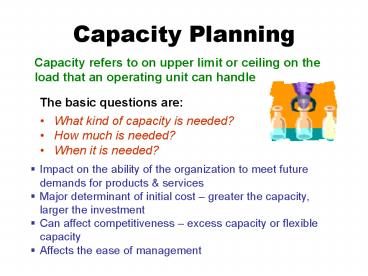Capacity Planning - PowerPoint PPT Presentation
1 / 7
Title:
Capacity Planning
Description:
Capacity Planning Capacity refers to on upper limit or ceiling on the load that an operating unit can handle The basic questions are: What kind of capacity is needed? – PowerPoint PPT presentation
Number of Views:49
Avg rating:3.0/5.0
Title: Capacity Planning
1
Capacity Planning
Capacity refers to on upper limit or ceiling on
the load that an operating unit can handle
- The basic questions are
- What kind of capacity is needed?
- How much is needed?
- When it is needed?
- Impact on the ability of the organization to meet
future demands for products services - Major determinant of initial cost greater the
capacity, larger the investment - Can affect competitiveness excess capacity or
flexible capacity - Affects the ease of management
2
Capacity Planning
Design Capacity maximum attainable output
Effective Capacity maximum possible output with
scheduling difficulties, machine maintenance so
on
Effective capacity is always less than design
capacity
3
Capacity Planning
Determinants of Effective Capacity
- Facilities
- Design including size provision of expansion
- Location transportation cost, distance to
market, labor supply - Layout smoothness of flow, as will as lighting
ventilation
- Product / services
- Design easier the design, easier to produce
- Product Mix varieties of product reduce
capacity
- Process
- Quantity obvious determinant of capacity
- Quality low quality will require inspection
rework
4
Capacity Planning
Determinants of Effective Capacity
- Human Factor
- Job content
- Training/Experience
- Motivation
- Compensation
- Operational
- Scheduling differences in equipment capabilities
- Materials management shortage of materials/
complaints - Quality assurance in process incoming
materials
- External
- Product standard can restricts increasing
capacity - Safety regulations
- Unions
5
Capacity Planning
Capacity Requirement
Long term relates to overall level of capacity
e.g., facility size
Determined by forecasting demand over a time
horizon, and then converting those forecasts into
capacity requirement
- How long
- Slope of trend
Trend
Short term relates to probable variations e.g.,
seasonal, random
Deviations are important as they can place severe
strain to satisfy demand at sometimes yet
result in idle capacity at other times
6
Capacity Planning
Developing Capacity Alternatives
Design flexibility into systems Provisions for
futures expansions in the original design
Differentiate between new and mature
products/services Mature product/services tends
to be more predictable
Attempt to smooth out capacity requirement Need
to identify products which can offset each other
Prepare to deal with capacity chunks Capacity
increases are often acquired in fairly large
chunks
Take a big picture approach to capacity
change Important to consider how parts of the
system interrelate
Identify the optimal operation level In terms of
unit cost of output
7
Capacity Planning
Evaluating Alternatives
Financial Analysis
Cost volume Analysis
Total cost
- Pay back period
- Net present value
- Internal rate of return
Variable cost
Total revenue
Total Profit
For breakeven































